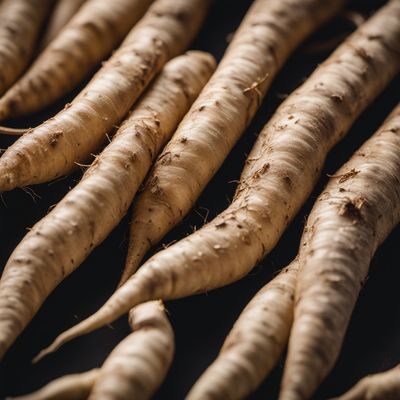
Ingredient
Tropical root and tuber vegetables
The Vibrant Bounty: Tropical Root and Tuber Vegetables
Tropical root and tuber vegetables include a variety of plants such as yams, taro, cassava, sweet potatoes, and malanga. These vegetables are known for their starchy texture and unique flavors. Yams are sweet and creamy, while taro has an earthy taste. Cassava is nutty and versatile, and sweet potatoes offer a balance of sweetness and earthiness. These vegetables are used in a wide range of dishes, including soups, stews, curries, and side dishes.
Origins and history
Tropical root and tuber vegetables have been cultivated for centuries in tropical regions around the world. They are native to various parts of Africa, Asia, and the Americas. These vegetables have played a significant role in the diets of indigenous cultures and have become staples in many cuisines. They are valued for their ability to thrive in challenging growing conditions and provide sustenance in areas with limited resources.
Nutritional information
Tropical root and tuber vegetables are a good source of complex carbohydrates, dietary fiber, and essential vitamins and minerals. They are particularly rich in vitamin C, potassium, and manganese. These vegetables are also low in fat and calories, making them a healthy addition to a balanced diet.
Allergens
Tropical root and tuber vegetables, such as cassava and taro, may contain naturally occurring toxins that need to be properly processed before consumption. It is important to peel, cook, and prepare these vegetables thoroughly to remove any potential toxins and ensure their safety.
How to select
When selecting tropical root and tuber vegetables, choose ones that are firm and free from blemishes or soft spots. The skin should be smooth and intact. Avoid vegetables that are overly soft, moldy, or have a strong odor. Opt for smaller or medium-sized vegetables, as they tend to be more tender and flavorful.
Storage recommendations
To store tropical root and tuber vegetables, keep them in a cool, dark place with good ventilation. Avoid storing them in the refrigerator, as the cold temperature can negatively affect their texture and flavor. Most tropical root and tuber vegetables can be stored for several weeks to a few months, depending on the variety.
How to produce
Tropical root and tuber vegetables can be grown in warm climates with well-drained soil and plenty of sunlight. They require regular watering and can be harvested when the leaves start to turn yellow or brown. The exact growing conditions and harvesting times may vary depending on the specific vegetable.
Preparation tips
Tropical root and tuber vegetables can be prepared in various ways, including boiling, steaming, roasting, or frying. They can be used as a base for soups and stews, mashed or pureed for side dishes, or sliced and roasted for a crispy texture. These vegetables can also be used in desserts, such as pies and cakes, for added sweetness and moisture.
Culinary uses
Tropical root and tuber vegetables are used in a wide range of dishes from different cuisines around the world. They are commonly found in African, Asian, Caribbean, and Latin American cuisines. These vegetables are used in soups, stews, curries, side dishes, and even desserts.
Availability
Tropical root and tuber vegetables are commonly available in tropical regions, including Africa, Asia, the Caribbean, and parts of South America. They can also be found in specialty grocery stores or ethnic markets in other regions.
More ingredients from this category

Other tropical root and tuber vegetables
Exotic Underground Gems

Arrowroots and similar-
The Versatile Tubers: Unveiling the World of Arrowroots and Similar Ingredients

Cassava roots and similar-
The Versatile Tuber: Unleashing the Potential of Cassava

Yams and similar-
The Versatile Tuber: Exploring Yams and Similar Varieties

Sweet potatoes and similar-
The Versatile Tubers